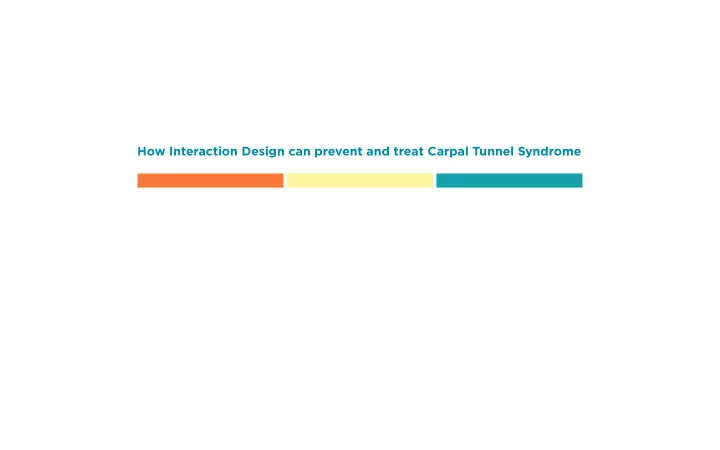

How Interaction Design can prevent and treat Carpal Tunnel Syndrome
How can individuals who repetitively use computers for work, use Interaction Design as a means to engage them in the healing practices and exercises of combatting Carpal Tunnel Syndrome?
Meet The Experts Stephanie Martz Nancy Hackett Harrison Derek J. Dean Physical Therapist/Owner of Functional Graduate student in Psychology and Director of Administrative Services at Boulder Physical Therapy LLC Neuroscience at CU Boulder County Public Health. Lab Research Assistant at CU Boulder Nancy spent 15 years as a professional ski instructor, This is an organization with approximately 250 fascinated by how people moved and how the body employees. As a Public Health department, they Before becoming a graduate student in the interacted with skis and snow. She earned her Alpine actively try to promote a healthy and active lifestyle Department of Psychology and Neurosceince and Level III Certifjcation (full alpine) and then continued within the constraints of an offjce environment. In the University of Colorado Boulder, Derek studied her study of biomechanics, graduating from the addition, Boulder County is extremely supportive Philosophy and English Literature at the University University of Colorado Health Sciences Program with of employee wellness and has contracted with of Denver and the University of Oxford as well as a Masters of Science in Physical Therapy. Simply Well to provide personal coaching and the basic sciences at Columbia University. He has support to employees to maintain a healthy lifestyle. worked as a volunteer and research assistant on Frustrated with the limitations of some traditional This support includes blood/BMI screening, gym a mental health crisis prevention hotline and as a practices of physical therapy, Nancy pursued discounts, incentives for participating in healthy volunteer in several mental health treatment facilities certifjcation in Functional Manual Therapy through the events (such as Bike to Work Day) and a discount around Boulder. Currently, his interests include Institute of Physical Art (IPA), the national accrediting on employee insurance premiums if they participate biological, social and psychological markers of risk; body for FMT. She earned Functional Manual in the Simply Well program. Stephanie is responsible emotion; cognitive behavioral and mindfulness Therapist Certifjcation and continued as a Fellow for the overall administration of the workplace based interventions for mental illness; and software in the Director’s Program, mentoring under Gregg including human resources management and applications for psychological stimuli. Johnson and Vicky Saliba Johnson. Nancy is now a offjce management. Many of the employees make member of the faculty of IPA, teaching Functional requests to modify the offjce to meet their personal Gait and similar courses to physical therapists around needs for a healthier workspace with a variety of the country. suggestions and requests. Stephanie must weigh these requests against budget constraints, the Always seeking to deepen her understanding of how needs of the job, legal requirements such as the the body should move, Nancy earned a Fellowship in Family Medical Leave Act (FMLA), Americans with the American Academy of Orthopedic and Manual Disabilities Act (ADA) and issues of transparency and Physical Therapists (FAAOMPT) in 2009. fairness to other employees. Requests to modify the personal workspace that are accompanied by a doctor’s note or an ergonomic evaluation are usually made. However, adjustments to common areas to accomodate the needs of one employee are less likely to be approved.
What people with CTS should be doing Why people don’t do these -Too much work to do -Easily avoidable/forgettable -Not enough of a reward/short term gratifjcation -Lack of motivation -Identify the source of the problem -Stretching afgected areas regularly -Movements in opposite direction
What are the key features needed to be successful? “It” needs to... -Act as a reminder -Be seamless throughout the users workday -Conditions the user -Knows the proper movements and stretches that need to be accomplished. -Have a feedback system that signals CORRECT/INCORRECT, COMPLETION -Have a system of documentation and progress -Provide a reward/benefjt/sense of accomplishment
Successful Apps with enagaging features
TASK MAP WORK REMINDER ACCEPT & SET IGNORE PLACE PHONE SET REMINDER EXERCISE 1 EXERCISE 2 COMPLETION SUMMARY EXIT
Engagement Concepts FUN REWARD INCENTIVE
Recommend
More recommend